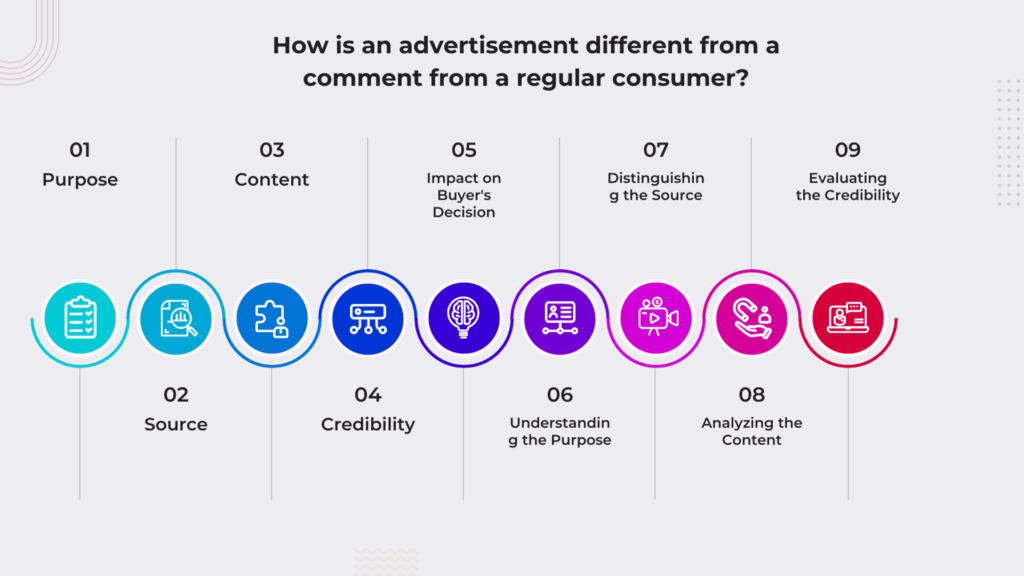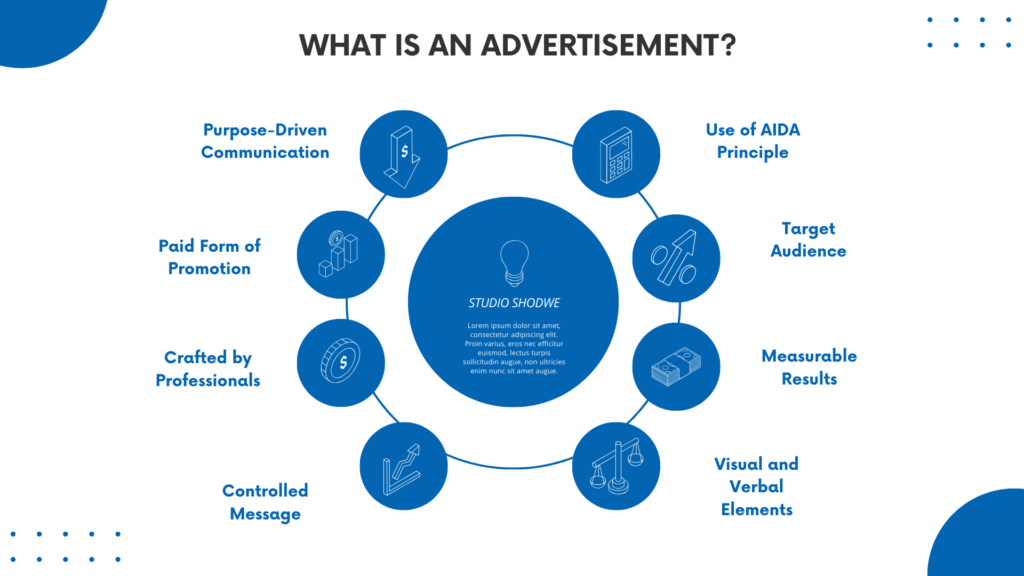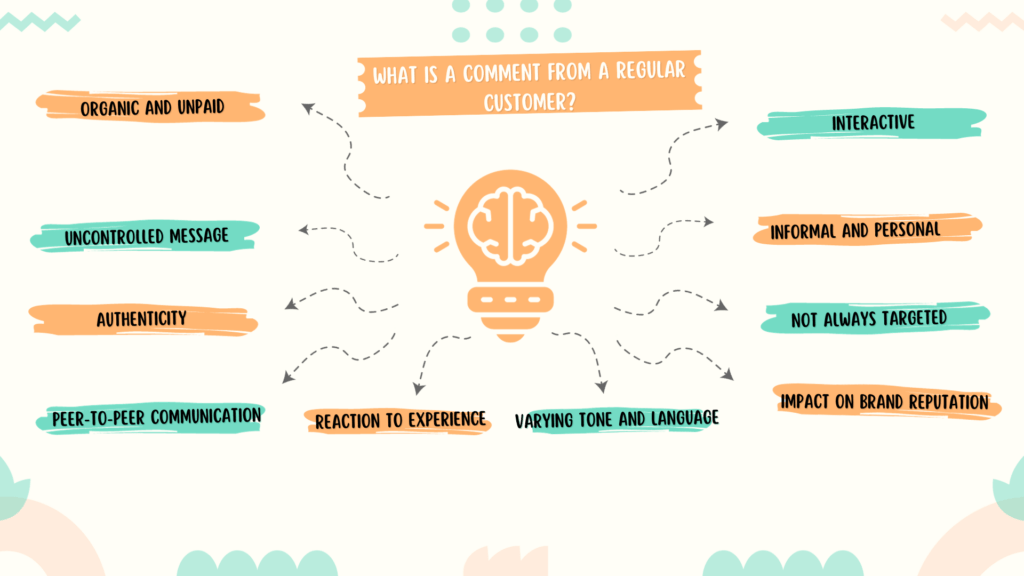How is an advertisement different from a comment from a regular consumer?

How is an advertisement different from a comment from a regular consumer? It is a pertinent question that is often confusing for students. In this comprehensive post we analyze the various facets of this question with this comprehensive tabulated overview.
Purpose: An advertisement is a paid communication aimed at promoting a product, service, or idea to persuade potential customers to take a specific action. On the other hand, a comment from a regular consumer is an individual’s personal opinion or experience with a product or service.
Source: Advertisements are created and distributed by companies or brands, often through marketing agencies. In contrast, a consumer comment is typically unsolicited feedback provided by an individual consumer.
Content: Advertisements are typically well-crafted, incorporating persuasive writing techniques and psychological principles to influence consumer behavior. Consumer comments, however, are often more raw and authentic, reflecting personal experiences and emotions.
Credibility: As advertisements are promotional, consumers might perceive them with skepticism. Conversely, comments from regular consumers are often viewed as more credible and trustworthy as they come from real users of the product or service.
Impact on Buyer’s Decision: Both advertisements and consumer comments can influence a buyer’s decision. However, while advertisements aim to create a positive image and desire for a product or service, consumer comments can either reinforce or challenge these perceptions based on their personal experiences.
Understanding the Purpose: Advertisements are designed to entice potential customers into purchasing a product or service, while consumer comments are personal feedback or experiences shared by individuals.
Distinguishing the Source: Advertisements are professionally crafted and distributed by brands or marketing agencies, whereas consumer comments are organic, unsolicited opinions from individuals who have used the product or service.
Analyzing the Content: Advertisements use persuasive writing techniques, psychological triggers, and strategic messaging to influence consumer behavior. On the other hand, consumer comments are candid, unfiltered, and based on personal experiences.
Evaluating the Credibility: Although advertisements are more polished and professional, they may be met with skepticism due to their promotional nature. Consumer comments, being unbiased personal experiences, are often perceived as more credible and trustworthy.
How is an advertisement different from a comment from a regular consumer? – A Tabulated Overview
|
Point of Difference | Advertisement | Comment from a Regular Customer |
| Nature | Paid and controlled by the brand | Organic and not controlled by the brand |
| Purpose | To persuade and promote a product or service | To provide feedback or share personal experiences |
| Authenticity | May be perceived as less authentic due to being a paid promotion | Often perceived as more authentic due to being a personal experience |
| Communication Type | Brand-to-consumer communication | Peer-to-peer communication |
| Timing | Created before the consumer experience to influence decision-making | Posted after the consumer experience to share personal insights |
| Tone and Language | Professionally crafted with persuasive language and a consistent tone | Varies greatly, reflecting the individual’s personal communication style |
| Impact on Brand Reputation | Can enhance brand image, but effectiveness depends on consumer reception | Can significantly impact a brand’s reputation, both positively and negatively |
| Audience | Targeted at a specific audience | Can be viewed by anyone, not necessarily targeted |
| Formality | Formal and objective | Informal and personal |
| Interactivity | One-way communication (from brand to consumer) | Encourages interaction, either with the brand or with other consumers |
Let’s break down both contexts so that you can answer the question in a better way
What is an Advertisement?

Purpose-Driven Communication:An advertisement is a form of marketing communication specifically designed to persuade an audience to take a particular action, usually relating to the purchase or usage of a product or service. It’s a strategic effort by a business to promote its offerings and build brand awareness.
Paid Form of Promotion: Advertisements are typically paid for by the brands or businesses they represent. They invest in ad space or airtime on various platforms such as television, radio, print media, and digital platforms to reach their target audience.
Crafted by Professionals: Advertisements are usually created by professional copywriters, graphic designers, and marketing strategists. They use proven marketing techniques, psychological principles, and creative skills to craft compelling messages that appeal to consumers’ emotions and needs.
Controlled Message: In an advertisement, the message is completely controlled by the brand. They choose what to say, how to say it, and where to say it. This allows them to present their product or service in the best possible light and shape the narrative around their brand.
Use of AIDA Principle: Advertisements often use the AIDA (Attention, Interest, Desire, Action) principle. They first grab the audience’s attention, then generate interest in the product or service, create a desire for it, and finally, encourage the audience to take action, such as making a purchase or signing up for a service.
Target Audience: Advertisements are directed towards a specific target audience. The content, tone, and message of the ad are tailored to appeal to this group’s interests, needs, and preferences.
Measurable Results: The impact of advertisements can be measured through various metrics like reach, impressions, clicks, conversions, etc. This helps businesses understand the effectiveness of their advertising efforts and make necessary adjustments.
Visual and Verbal Elements: Advertisements often combine visual and verbal elements to effectively convey the brand’s message. This can include images, videos, text, music, voiceovers, and more, all working together to create a persuasive and memorable ad.
What is a Comment from a Regular Customer?
A comment from a regular consumer, often referred to as customer feedback or user-generated content, is a form of communication that provides insights into a consumer’s experience with a product or service. Here are some key characteristics that differentiate it from an advertisement:

Organic and Unpaid: Unlike advertisements, comments from regular consumers are not paid for by the brand. They are organic expressions of the consumer’s personal experiences, opinions, and sentiments about a product or service.
Uncontrolled Message: The brand has no control over what a consumer says in their comment. While advertisements allow brands to shape their narrative, consumer comments can be positive, negative, or neutral, reflecting the true experiences of the consumer.
Authenticity: Comments from regular consumers are often seen as more authentic and trustworthy than advertisements. They provide real-life testimonials that other consumers can relate to, making them a powerful influence on purchasing decisions.
Peer-to-Peer Communication: While advertisements are a form of brand-to-consumer communication, consumer comments are a form of peer-to-peer communication. They provide a platform for consumers to share their experiences and opinions.
Reaction to Experience: Consumer comments are typically posted after the consumer has purchased and used a product or service. They are reactions to actual experiences, whereas advertisements are designed to persuade consumers to have an experience.
Varying Tone and Language: While advertisements are professionally crafted with persuasive language and a consistent tone, consumer comments can vary greatly in tone, language, and grammar. They reflect the individual’s personal communication style.
Impact on Brand Reputation: Consumer comments can significantly impact a brand’s reputation. Positive comments can enhance a brand’s image, while negative comments can damage it. Brands often monitor and respond to consumer comments to manage their reputation.
Not Always Targeted: Unlike advertisements, which are targeted at a specific audience, consumer comments can be seen by anyone who visits the platform where they are posted. They can influence a wide range of potential consumers.
Informal and Personal: Consumer comments are typically informal and personal. They may include personal anecdotes, emotions, and subjective opinions, unlike advertisements which are more formal and objective.
Interactive: Consumer comments often encourage interaction, either with the brand or with other consumers. They can spark discussions, debates, and further comments, creating a dynamic conversation around the brand and its products or services.
Samrat is a Delhi-based MBA from the Indian Institute of Management. He is a Strategy, AI, and Marketing Enthusiast and passionately writes about core and emerging topics in Management studies. Reach out to his LinkedIn for a discussion or follow his Quora Page
